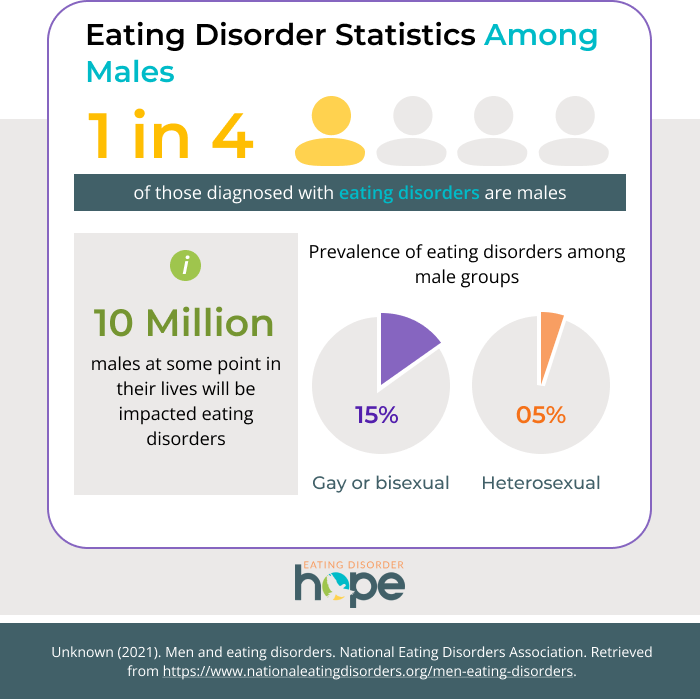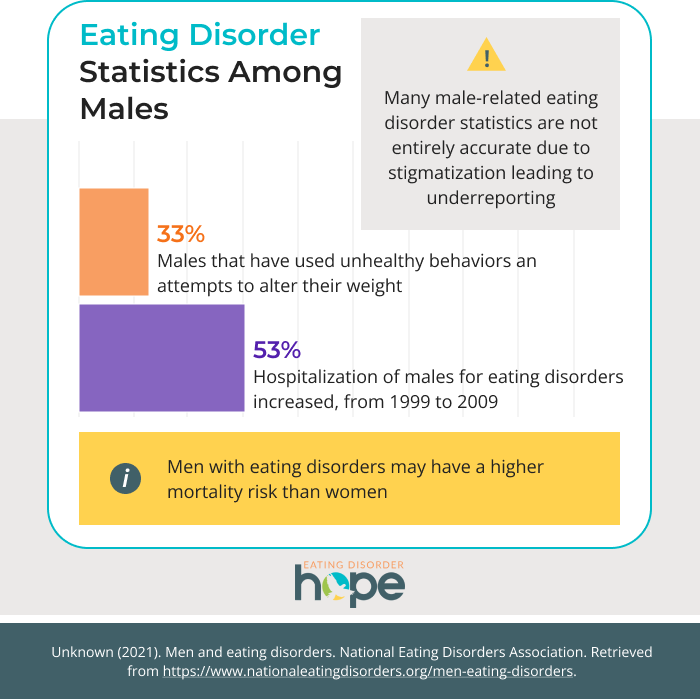- Calls to this hotline are currently being directed to Within Health, Fay or Eating Disorder Solutions
- Representatives are standing by 24/7 to help answer your questions
- All calls are confidential and HIPAA compliant
- There is no obligation or cost to call
- Eating Disorder Hope does not receive any commissions or fees dependent upon which provider you select
- Additional treatment providers are located on our directory or samhsa.gov
Eating Disorders in Males
Eating disorders in Men have been around for many years and until recently were typically viewed as a female issue. Not anymore. Today, anorexia, bulimia, and especially binge-eating disorder are on the rise in the male population. Anorexia is now diagnosed in boys as young as eight and a full 40% of those with binge-eating disorders are male.
[toc levels=1 title=”Article Contents”]Andrew Walen provides fascinating insight and understanding about males dealing with disordered eating. A must watch for all loved ones and guys seeking to understand the male experience of eating disorders. Learn more about Andrew & The Body Image Therapy Center
Male Eating Disorder Statistics
Many of the statistics related to eating disorders in men aren’t entirely accurate. Much of this is due to the continued stigmatization of men struggling with eating disorders which leads to underreporting. Recognizing this, researchers have attempted to focus more on the specific impact of eating disorder in men and have generated some important information, such as:
- 25% of those diagnosed with eating disorders are males [1].
- 33% of males have used unhealthy behaviors an attempts to alter their weight [1].
- Eating disorders will impact 10 million males at some point in their lives [2].
- From 1999 to 2009, hospitalization of males for eating disorders increased by 53% [2].
- 15% of gay or bisexual men report struggling with an eating disorder [2].
- 5% if heterosexual men report struggling with an eating disorder [2].
- Men with eating disorders may have a higher mortality risk than women [2].


What Causes Eating Disorders in Males?
There is no one cause of eating disorders, however, research does indicate that there are factors that make males more at-risk for eating disorders.
A history of traumatic experiences such as sexual, physical, verbal, and/or emotional abuse as well as bullying leave males at a higher risk for eating disorder behaviors. Men often under-report traumatic experiences, which can further increase their risk for maladaptive coping skills, as they do not seek effective support. One study notes that men who experience physical or sexual trauma often respond by attempting to alter their bodies to become more “masculine,” attempting to gain muscle to protect themselves from future victimization, often by any means necessary [4].
Male athletes are also 2 to 3 times more likely than non-athletes to develop eating disorder behaviors, as “more men than women are motivated to lose weight, or sometimes to gain weight, to achieve optimal performance in sports, and even in some cases, to be eligible to compete [3] [4].” One study notes that “male athletes might not engage in self-induced vomiting, purging through excessive exercise, overtraining in the gym, and chronic caloric restriction or macronutrient manipulation coupled with over-reliance on nutritional supplements and protein powders can severely harm the body over time [3].” Additionally, “Other components of bulimia, such as binge-eating, are often rationalized away in the context of sport. For instance, a “big male appetite,” or “eating big to bulk up for sport,” are both seemingly normalized for boys and for men in our culture [3].”
Research indicates that those in the LGBTQ+ community experience elevated levels of eating disorder diagnoses. Some believe this is due to the community’s increased awareness and reporting of these issues. Even so, the discrimination that individuals in the LGBTQ+ community might experience can cause trauma, leaving them at an increased risk for eating disorder development. One study differentiates that “being a gay male is not, in itself, predictive of males developing an eating disorder or muscle dysmorphia; however homosexuality is an indication for a male to be more at risk of developing a disorder [4].”
Comorbid mental illness also leaves men at higher risk for eating disorders. While our society is moving forward in its understanding of the gender spectrum, there are still internalized messages regarding masculinity and femininity. The pressure placed on boys and men to be “masculine” leads to internalized depression and shame, making them more susceptible to maladaptive coping skills such as eating disorder behaviors.
Types of Eating Disorders in Men
While eating disorders do not impact any 2 individuals in the same manner, there are presentations and patterns of eating disorders that seem to be specific to male populations.
Male Anorexia Nervosa
25% of men report struggling with anorexia nervosa, an eating disorder characterized by severe restriction of nutritional intake and distorted body image. Presentation of this disorder may be similar to women in that men restrict their food intake or engage in rigid food rules, however, their motivations may differ. Women that restrict their intake to alter their bodies are often attempting to achieve thinness. Men, however, are often attempting to become more lean yet toned. This is likely due to societal pressures regarding what a male body “should” look like versus a female body.
Anorexia Nervosa motivations are not as simple as wanting to change the body, however, and men experience many of the same triggers and psychological risk factors as women such as perfectionist tendencies, issues with control, difficulty regulating emotions, experiencing a history of trauma, and more.
Bulimia Nervosa in Men
Similar to Anorexia Nervosa, 25% of men report that they struggle with Bulimia Nervosa. This eating disorder is characterized by individuals engaging in binge episodes followed by efforts to purge the food consumed through compensatory behaviors such as vomiting, exercise, and/or diuretic/laxative use. Bulimia behaviors can often be observed in male athletes as men commonly utilize exercise as compensatory behaviors. Approximately 70% of male athletes report engaging in compensatory behaviors [3].
Male Binge Eating Disorder
Binge Eating Disorder (BED) is the most common eating disorder diagnosis found in males. This disorder involves individuals engaging in bingeing behaviors as one might with bulimia nervosa, however, those struggling with BED do not engage in compensatory behaviors after bingeing. 36% of men and boys struggle with BED and, of those diagnosed with BED, 40% are male [2].
Eating Disorders in Men: What are the Risks?
Individuals in male bodies have a different physical makeup than those in female bodies. This difference alters how disordered eating behaviors such as purging, restricting, bingeing, etc will impact the individual physically.
Side Effects of Anorexia in Men
Men will experience many of the same physical impacts of anorexia nervosa than women with a few differences, a key one being that as opposed to malnourishment impacting the menstrual cycle, it will impact the individual’s testosterone levels. In addition, side effects of anorexia in men include:
- Dry skin and hair.
- Difficulty regulating body temperature.
- Fatigue.
- Dizziness.
- Irregular heartbeat.
- Altered sex drive.
- Impaired immune system.
- Mood dysregulation.
- Impaired bone density.
Male Bulimia Side Effects
Bulimia can have severe impacts on the body, as purging and exercising behaviors can be very depleting to the body’s stores. Impacts of bulimia on males include:
- Tooth damage and decay.
- Gastrointestinal complications.
- Organ damage.
- Cardiovascular issues.
- Muscle weakness.
- Low bone density.
- Impaired immune system functioning.
- Depression.
- Anxiety.
- Dry/brittle hair and skin.
- Impaired vital signs.
- Increased suicidal ideation.
Eating Disorder Treatment for Men
It is more difficult for men to find eating disorder treatment, as there are fewer inpatient and residential treatment centers that have beds available for men or that are gender inclusive. Additionally, eating disorder professionals that are educated in addressing eating disorder factors that are male-specific are less common.
Even so, there is increasing support for men with eating disorders that can be found through advocacy organizations. Additionally, online communities have begun to fill the space required for men to receive support and find resources.
If you or a loved one are struggling with an eating disorder and identify as male, speak with your medical and/or therapeutic professional and reach out to organizations such as NEDA and Eating Disorder Hope to find out how you can receive the support you deserve to free yourself.
Ways To Help with Body Image and Eating Disorders in Men
If your loved one is struggling with an eating disorder, the following are ways in which you can offer support to the male in your life:
- Help boys understand that to fit in they don’t have to be muscle-bound and super-athletes. Boys need the same help as girls fitting comfortably into their genes.
- Boys need help with the grow-up-fast mentality pedaled by our media. Tell them there is no rush.
- Help boys understand there is no need to hyper-control their body. Both boys and girls need to undo mistaken notion that the body can be shaped and molded, at will, to fit a cookie-cutter image of the perfect body.
- Help boys understand their locus of control needs to be more on the inside, not on the outside, when it comes to understanding what is valuable about themselves.
- Help your son with an eating disorder develop age-appropriate autonomy, even if he is dependent on you for guidance around eating and exercise. Help him transition from boyhood to adulthood by encouraging age-appropriate responsibilities and social behaviors. This helps support developing manhood and increasing responsibility in ways that are not focused on looks.
- Help boys understand that most kinds of power do not come with big muscles and a “might makes right” attitude.
- Help boys find relief from agonizing over their appearance around puberty by helping them accept their bodies as they are. Help them focus on developing other aspects of who they are, other than their looks.
- If your son is seeking refuge in anorectic regression to pre-puberty, help him get to professional assistance. Do your best to support a dialog about what is fueling his maturity fears. Sometimes just making time to do activities together provides the best opportunity for dialog and exchange.
- Be sure to seek treatment at a qualified eating disorder center.
Articles on Eating Disorders in Men
- Muscle dysmorphia is a type of Body Dysmorphic Disorder and primarily take place in men. However, Muscle Dysmorphia is a psychological condition, and it often goes untreated because it is overlooked as a healthy interest in being in good shape. Even though the male is developing an unhealthy view of himself and possibly an eating disorder, it is uncommon for these individuals to seek treatment.
- Young men may encounter a myriad of issues pertaining to their weight and body image while in college. While low self-esteem and body image concerns may be something that is commonly thought to be an issue women deal with, studies have shown this idea to be false.
Resources
[1] Unknown (2021). Anorexia in men and boys: treatment and statistics. American Addiction Centers. Retrieved from https://americanaddictioncenters.org/male-eating-disorders/anorexia. [2] Unknown (2021). Men and eating disorders. National Eating Disorders Association. Retrieved from https://www.nationaleatingdisorders.org/men-eating-disorders. [3] Stranberg, M. (2019). Four things you might not know about men and bulimia. Walden Behavioral Care. Retrieved from https://www.waldeneatingdisorders.com/blog/four-things-you-might-not-know-about-men-and-bulimia/. [4] Strother, E. et al. (2012). Eating disorders in men: underdiagnosed, undertreated, and misunderstood. Eating Disorders, 20:5.Author: Margot Rittenhouse, MS, LPC, NCC
Page Last Reviewed and Updated By: Jacquelyn Ekern, MS, LPC 12/21/21

